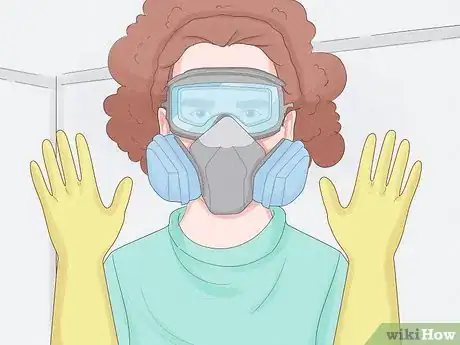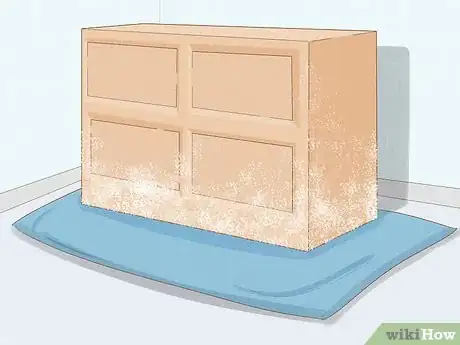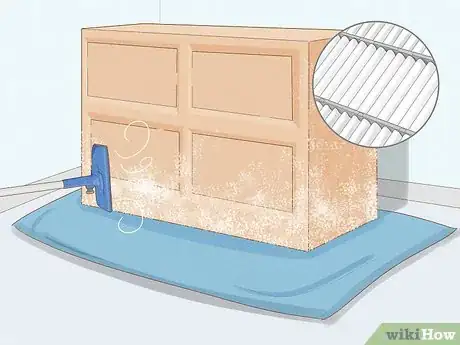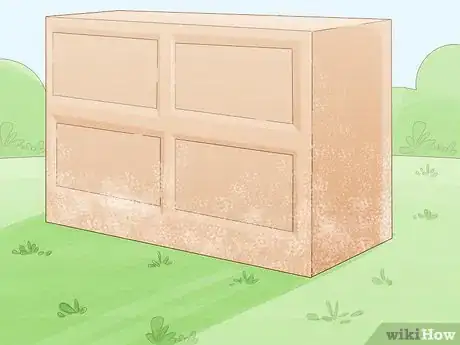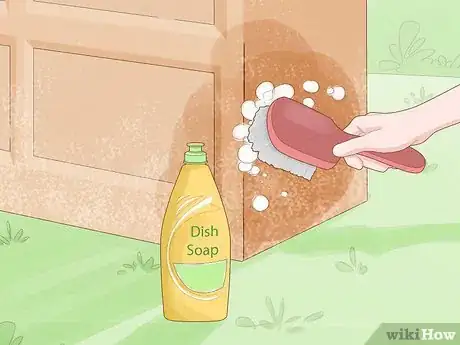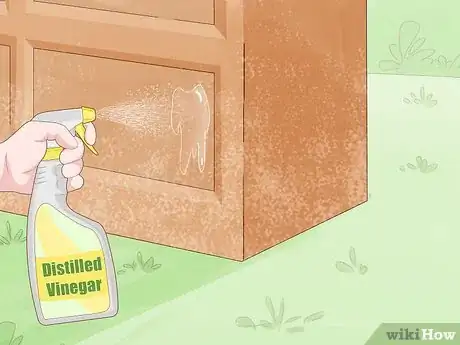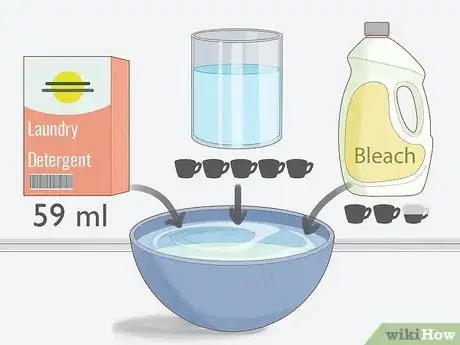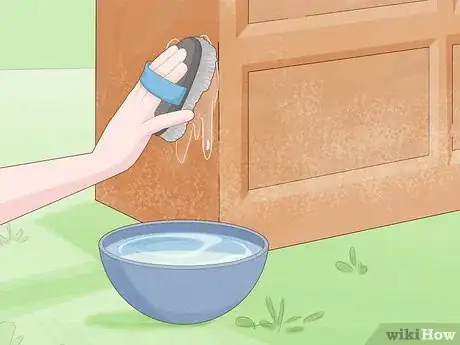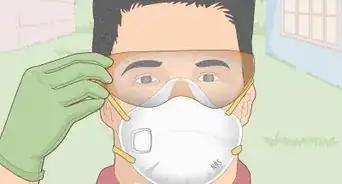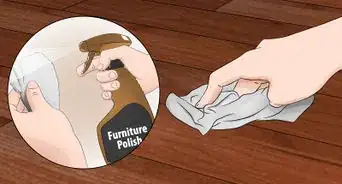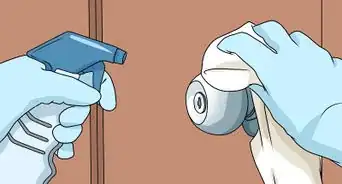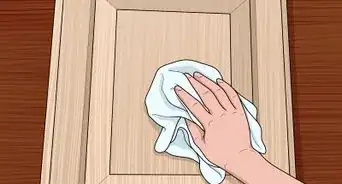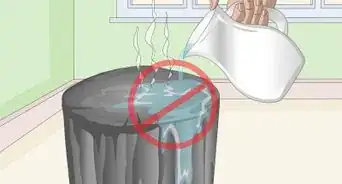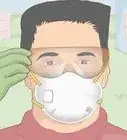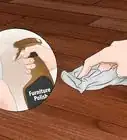This article was co-authored by Susan Stocker. Susan Stocker runs and owns Susan’s Green Cleaning, the #1 Green Cleaning Company in Seattle. She is well known in the region for outstanding customer service protocols — winning the 2017 Better Business Torch Award for Ethics & Integrity —and her energetic support of green cleaning practices.
wikiHow marks an article as reader-approved once it receives enough positive feedback. In this case, 93% of readers who voted found the article helpful, earning it our reader-approved status.
This article has been viewed 932,283 times.
Mold spores float through the air, indoors and out, undetected until they start growing. Given the right conditions, like warmth and moisture, they begin to grow mold. It can be devastating to find your favorite furniture speckled with mold spots. Prep to clean the mold by moving your furniture somewhere the mold won't spread and vacuuming up loose spores. Clean light mold with sunlight, cheap vodka, and dish soap. Remove stubborn mold with a bleach solution or by sanding the mold out of the furniture.
Steps
Prepping to Clean the Mold
-
1Put on rubber gloves, safety goggles, and an air mask. Mold spores can be very harmful to your health, especially if they get into your lungs. To prevent this, whenever cleaning mold you should wear an air mask, rubber gloves, and safety goggles without air vents.[1]
- Due to the especially harmful effects of spores on the lungs, a N95 mask should be used. These can be bought at most hardware stores.
- If you are allergic to mold or mold sensitive, cover as much of your skin as possible. Wear a long sleeve shirt and coveralls, in this case.
-
2Prevent the spread of mold spores by cleaning furniture outdoors. If you don't have any other options, you may clean mold from furniture inside, though you should open windows before starting.[2] During the cleaning process you might accidentally spread mold spores. To prevent mold from spreading to other pieces of furniture or parts of your house, clean outdoors.
- If you move the furniture outside, slit a garbage bag or two and tape the bag(s) around the furniture. This will prevent the spread of spores when transporting the furniture through your house.
- Many cleaning agents, like bleach, give off harmful fumes. At minimum, you should clean in a well-ventilated area.
Advertisement -
3Vacuum the areas with mold. A vacuum with an arm attachment and a HEPA filter will suck up loose spores along with dust and dirt. Pass the vacuum slowly over moldy areas several times.[3]
- When emptying the bag or canister of the vacuum, do so outside and into a plastic bag. Seal the bag tightly and throw it away.[4]
Cleaning Light Mold
-
1Fight very light mold with sunlight. Very light mold and musty smells can often be eliminated by airing your furniture out in sunlight. Position the furniture outside in the early morning, after the dew has evaporated (if there is any). Bring the furniture back inside at sunset. Repeat this for another day or two if necessary.
- Even when dealing with light mold, be sure you wear gloves, an air mask, and googles. Light mold still produces harmful spores.
- Mold thrives on moisture. If your home climate is humid, place your furniture in a small room with a dehumidifier for similar results to a sunlight cleaning.[5]
- To improve the mold fighting power of the sunlight, mix equal parts water and white vinegar and lightly spray the furniture in the morning when placing it outside.
-
2Mist light mold with vodka. Light mold, or mold that resisted a sunlight cleaning, can be handled with a spray bottle and cheap vodka. Add the vodka to the spray bottle and mist the whole piece of furniture. Allow it to air dry in direct sunlight for best results.[6]
- Wood that is painted or stained isn't likely to have been penetrated below the surface by the mold. In these cases, mild cleaners should work.
-
3Scrub away heavier mold with dish soap and a soft bristle brush. Mold that withstood sunlight and vodka can often be removed with a mild household detergent. Mix dish soap in a bucket of warm water and gently scrub moldy areas with a soft bristle brush with a circular motion.
- When finished cleaning, wipe the surface of your furniture with a damp towel. If no mold remains, wipe the wood once more with a dry rag. If mold remains, repeat this process.
- Before doing this, you should try brushing an out of sight area on the furniture with the solution first. Some brushes may damage certain finishes.[7]
-
4Opt for distilled vinegar when dish soap fails. Distilled white vinegar is an excellent mold killing agent. Should dish soap be too weak to remove the mold, add vinegar to a spray bottle. Spray the furniture thoroughly with the vinegar. Wait about an hour, then wipe the surface with a damp cloth.[8]
- Reapply the vinegar again in this fashion if necessary. Wipe the wood thoroughly with a dry rag when the mold is removed.
Removing Stubborn Mold
-
1Mix a bleach solution for stubborn mold. In a bucket, mix together a household detergent, like dish soap, bleach, and water. Use a quarter cup (59 ml) of detergent, 2½ cups (591 ml) of bleach, and 5 cups (1.2 L) of water. Stir the solution with a utensil to evenly distribute the ingredients.[9]
- Only mold on the surface of your wooden furniture will be removed by bleach alone. Mold that has sunk roots into the wood will require a surfactant added, like detergent.
- Bleach can lighten or completely whiten the colors of some dyed cloth, like clothing or carpet. Take care when handling bleach, and consider wearing a smock or clothes you don't mind throwing away.
-
2Apply the bleach solution to the furniture. Dip a stiff bristle brush or a scrub sponge into your bleach solution. Use moderate pressure and move your cleaning tool in circles as you clean. After thoroughly cleaning moldy areas, allow the furniture to air dry. Repeat this process a second time if necessary.[10]
- For best results, move the furniture outside, clean it as described with the bleach solution, and then allow it to air dry in the sunshine.
- Using a stiff bristle brush on wooden furniture could damage its finish. If this happens to your furniture, you'll have to refinish the wood.
- If the bleach solution does not completely remove the mold, its roots may be sunk too deeply in the wood to be removed by cleaning agents alone.
-
3Sand off solution resistant mold. Use a fine grit (120 to 220 rating) sandpaper to lightly sand the moldy areas.[11] Sand while the wood is still damp to prevent spores from spreading. Clean sanded areas with the bleach solution after sanding and air dry the furniture.
- Even lightly sanding finished wood will cause damage to the finish and require refinishing once the mold is removed.
Expert Q&A
-
QuestionHow can I kill black mold?
 Susan StockerSusan Stocker runs and owns Susan’s Green Cleaning, the #1 Green Cleaning Company in Seattle. She is well known in the region for outstanding customer service protocols — winning the 2017 Better Business Torch Award for Ethics & Integrity —and her energetic support of green cleaning practices.
Susan StockerSusan Stocker runs and owns Susan’s Green Cleaning, the #1 Green Cleaning Company in Seattle. She is well known in the region for outstanding customer service protocols — winning the 2017 Better Business Torch Award for Ethics & Integrity —and her energetic support of green cleaning practices.
Green Cleaning Expert There is no eco-friendly way to kill black mold, and the spores can be dangerous. For these reasons, it is not recommend that you remove the mold yourself. You're much better off hiring a professional mold removal service to get rid of black mold. If you do decide to remove it yourself, wear a respirator and seal all areas of your home so that the potentially toxic spores aren't released into other areas of your home. You’ll need black mold removal products, which are easily found in home repair stores. Contrary to popular opinion, bleach does not kill black mold.
There is no eco-friendly way to kill black mold, and the spores can be dangerous. For these reasons, it is not recommend that you remove the mold yourself. You're much better off hiring a professional mold removal service to get rid of black mold. If you do decide to remove it yourself, wear a respirator and seal all areas of your home so that the potentially toxic spores aren't released into other areas of your home. You’ll need black mold removal products, which are easily found in home repair stores. Contrary to popular opinion, bleach does not kill black mold. -
QuestionWhat should I wear when cleaning mold?
 Susan StockerSusan Stocker runs and owns Susan’s Green Cleaning, the #1 Green Cleaning Company in Seattle. She is well known in the region for outstanding customer service protocols — winning the 2017 Better Business Torch Award for Ethics & Integrity —and her energetic support of green cleaning practices.
Susan StockerSusan Stocker runs and owns Susan’s Green Cleaning, the #1 Green Cleaning Company in Seattle. She is well known in the region for outstanding customer service protocols — winning the 2017 Better Business Torch Award for Ethics & Integrity —and her energetic support of green cleaning practices.
Green Cleaning Expert Mold spores are harmful to human health, so it's important to wear proper PPE. Put on ventless goggles, a face mask, and gloves before cleaning mold.
Mold spores are harmful to human health, so it's important to wear proper PPE. Put on ventless goggles, a face mask, and gloves before cleaning mold. -
QuestionCan vinegar kill mold?
 Susan StockerSusan Stocker runs and owns Susan’s Green Cleaning, the #1 Green Cleaning Company in Seattle. She is well known in the region for outstanding customer service protocols — winning the 2017 Better Business Torch Award for Ethics & Integrity —and her energetic support of green cleaning practices.
Susan StockerSusan Stocker runs and owns Susan’s Green Cleaning, the #1 Green Cleaning Company in Seattle. She is well known in the region for outstanding customer service protocols — winning the 2017 Better Business Torch Award for Ethics & Integrity —and her energetic support of green cleaning practices.
Green Cleaning Expert Yes! Distilled white vinegar is a natural mold killer. Simply add it to a spray bottle and spritz it all over the mold. Wait for about 1 hour, then wipe off the vinegar.
Yes! Distilled white vinegar is a natural mold killer. Simply add it to a spray bottle and spritz it all over the mold. Wait for about 1 hour, then wipe off the vinegar.
Warnings
- Mold that has aggressively infected your furniture may be impossible to remove. In this situation, you may need to throw the furniture away.⧼thumbs_response⧽
- Mold spores are harmful to humans. Always be sure to wear proper safety equipment when cleaning mold, like gloves, ventless googles, and an air mask.[12]⧼thumbs_response⧽
Things You'll Need
- Air mask (rated N95 or better)
- Bleach
- Clean rags
- Dishwashing detergent
- Distilled white vinegar
- HEPA filter equipped vacuum (preferably with a hose attachment)
- Rubber gloves
- Safety goggles
- Sandpaper (optional)
- Soft bristle scrub brush
- Sponge
- Spray bottle
- Stiff bristle scrub brush
References
- ↑ Susan Stocker. House Cleaning Professional. Expert Interview. 8 November 2019.
- ↑ https://www.michigan.gov/documents/mdch/STEPS_FOR_CLEANING_MOLD_MDCH_312223_7.pdf
- ↑ Susan Stocker. House Cleaning Professional. Expert Interview. 8 November 2019.
- ↑ http://www.goodhousekeeping.com/home/cleaning/tips/a22126/prevent-mildew/
- ↑ Susan Stocker. House Cleaning Professional. Expert Interview. 8 November 2019.
- ↑ http://www.organicauthority.com/sanctuary/5-ways-to-clean-your-home-with-yes-vodka.html
- ↑ https://www.michigan.gov/documents/mdch/STEPS_FOR_CLEANING_MOLD_MDCH_312223_7.pdf
- ↑ Susan Stocker. House Cleaning Professional. Expert Interview. 8 November 2019.
- ↑ https://www.bobvila.com/articles/how-to-remove-mold-from-wood/#.WOqRfNIrLIV
- ↑ https://www.bobvila.com/articles/how-to-remove-mold-from-wood/#.WOqRfNIrLIV
- ↑ https://www.bobvila.com/articles/2145-quick-tip-choosing-sandpaper/#.WOrmJtIrLIU
- ↑ Susan Stocker. House Cleaning Professional. Expert Interview. 8 November 2019.
About This Article
To remove light mold from wood furniture, add cheap vodka to a spray bottle and coat the furniture with it before allowing the piece to air dry in direct sunlight. To remove stubborn mold, scrub the furniture down with a detergent or bleach solution using a stiff-bristled brush. If the mold is extremely resistant, try sanding it away with sandpaper. Don't forget to wear rubber gloves, safety goggles, and an air mask when working around mold! For more tips on how to safely clean mold from your furniture, read on!
